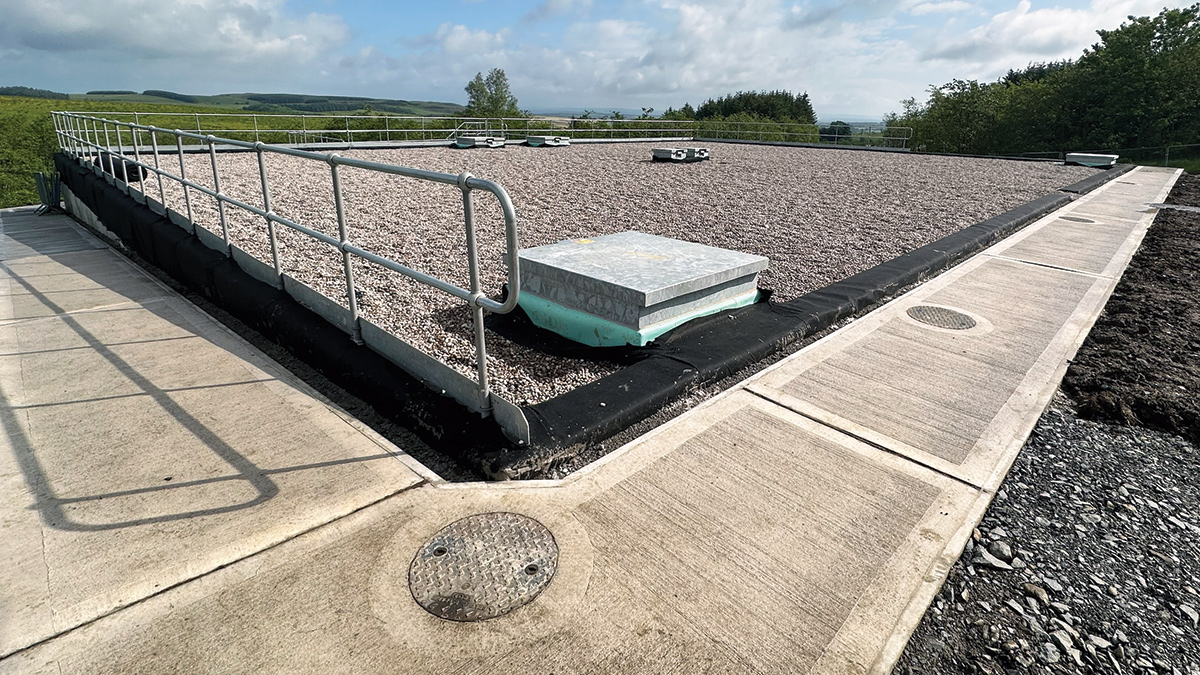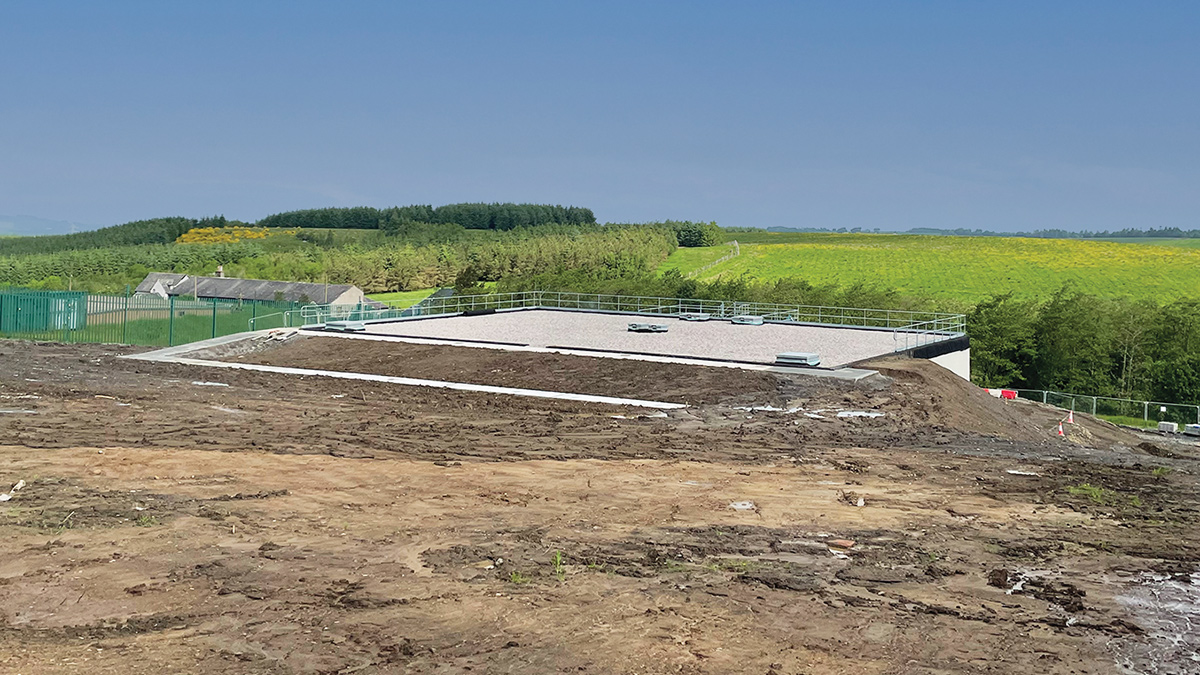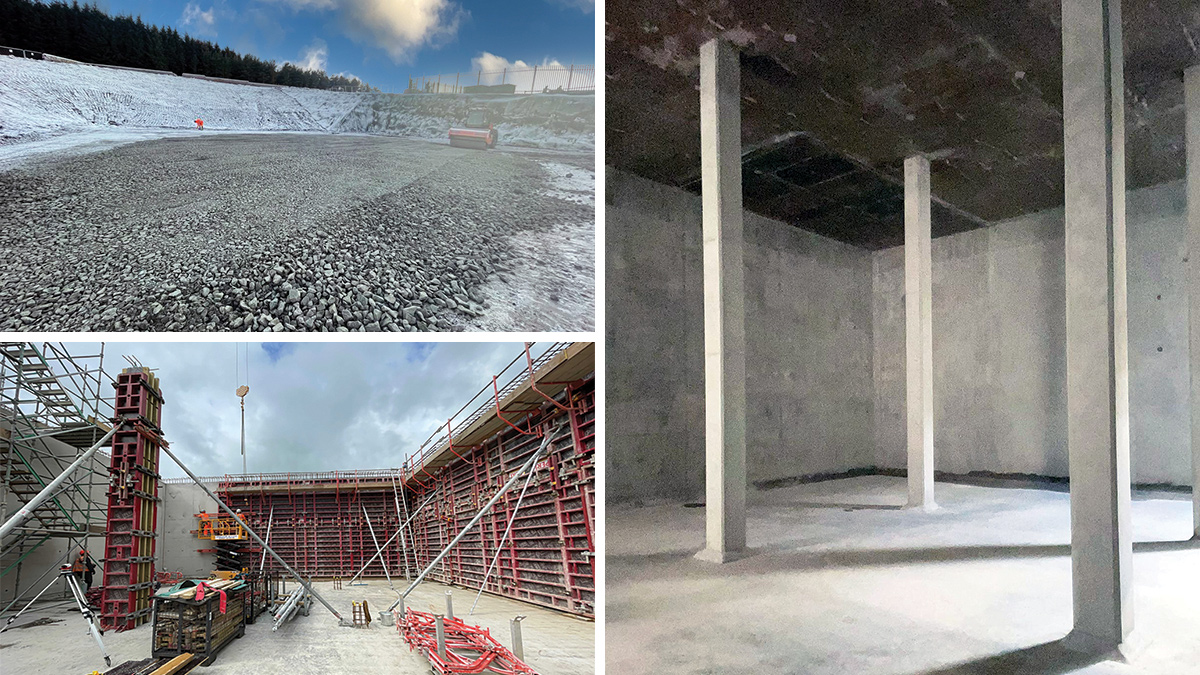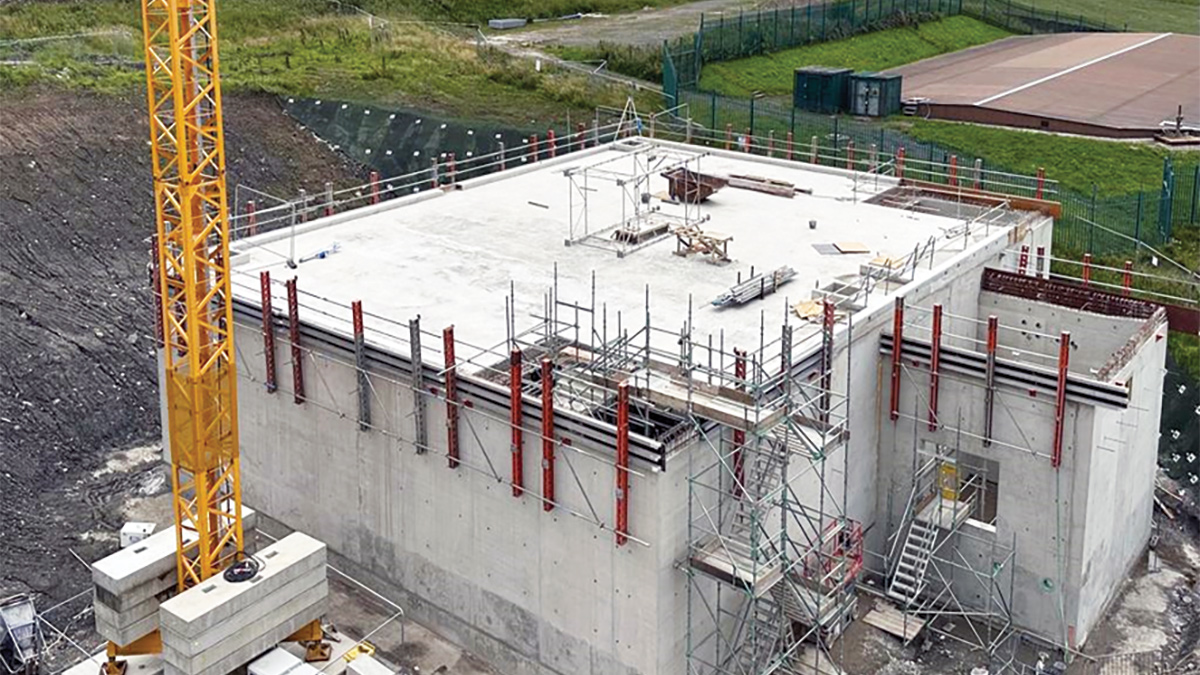Kerse Treated Water Storage Tank (2024)

The completed Kerse Treated Water Storage Tank (May 2024) - Courtesy of ESD JV
Kerse lies in open countryside approximately 3.5km from the former mining village of Patna in East Ayrshire, some 15km from the county town of Ayr. The newly constructed 3 megalitre capacity, twin cell, treated water storage (TWS) tank serves a local population of 6,500 private customers and businesses. It is situated immediately adjacent to the existing facility and is fed from the nearby Afton Water Treatment Works.
Scottish Water’s Non-Infrastructure Alliance Partner, ESD JV (a joint venture comprising MWH Treatment, Binnies and Galliford Try) commenced construction in July 2022. Water into supply was achieved on schedule on 21 May 2024.
Existing facility
The existing single cell, below ground 4.5 ML clear water storage tank dates from the 1930s. It is, therefore, an ageing asset whose deterioration has recently led to some failures in water quality and general lack of resilience in the system. These drivers led to a decision by Scottish Water to commission a £6.5m replacement. Forecast modest rises in local population numbers was a secondary consideration.
Challenges
The principal challenges were:
- How to build the new underground tank in a position immediately adjacent to the existing, still operating, facility. Non-interruption to the operation of the existing asset was a primary consideration.
- Working on the existing ageing network to fulfil the new process pipework.
- Undertaking testing and commissioning of the new asset whilst keeping the existing asset live and ensuring no negative impact on the network.
- How to stabilise the ground during excavations to ensure the continued, uninterrupted operation of the to-be-replaced tank and network pipelines.
- How to mitigate against poor soil conditions – mainly heavy clay – during two winter and spring seasons of heavy rain leading to severe drainage issues.
- The site was also located adjacent to a number of disused open-cast mines which were situated under a sludge restoration scheme, so continual coordination around access was key.
Scope
The contract specified the replacement of the existing almost 90 year-old tank with a 3 ML, twin-celled treated water storage tank to be constructed on the same site, contiguous with the structure of the old tank.
The dimensions of the new asset are 29m x 21.5m x 7m to be covered by a reinforced concrete roof with waterproof membrane.
All aspects of the design of the new tank were undertaken by ESD JV’s design and engineering department. Work started on-site in July 2022. In total, approximately 850m3 of concrete was poured to construct the new structure.

View of tank with backfill almost completed. Pedestrian crane on the left – Courtesy of ESD JV
Kerse Treated Water Storage Tank: Supply chain: key participants
- Client: Scottish Water
- Delivery contractor: ESD JV
- Geotech design: Stantec UK
- Tower crane base design: Noble Works Ltd
- Mechanical design/installation: Dustacco Engineering Ltd
- Electrical installation: RRC Project Solutions Ltd
- Soil nailing: Albion Drilling Group Ltd
- Waterproofing: Concrete Repairs Ltd
- Underpressure connections: Swan Pipelines
- Pressure testing: Pressure Test Scotland Ltd
- Tank disinfection: Panton McLeod Ltd
- Telemetry: ID Systems UK
- Formwork: Peri UK Ltd
- FRC: AJ McAlpine
- Instrumentation: Processplus Ltd
- Control valve: CLA-VAL UK Ltd
- DI pipework: Saint Gobain PAM UK
- PE pipework: FPP Scotland Ltd
- Metalwork: HK Gillies
- Scaffolding: JD Scaffolding Ltd
- Tower crane: Ladybird Crane Hire
- Security system: Pointer
- Access covers: Technocover Ltd
- Rebar: Midland Steel Reinforcement Supplier UK Ltd
- Concrete & aggregates: Breedon Group
- Aggregates: Hillhouse Quarry Group
Groundworks
In order to protect the viability of the existing tank, and as a consequence of above average rainfall in the winters and springs of 2022, 2023 and 2024, a complex bulk excavation operation was undertaken which included the extensive use of soil anchors to stabilise the ground.
This solution included some in-depth collaboration from the site team and specialist sub-contractor to design a solution to ensure no current live network pipes (which were only 6m from the top of the batter of the excavation) were damaged during the installation of the anchors. In order to achieve this, the site team undertook a survey of the existing network to establish the precise coordinates of each pipeline.
This allowed for the design to be altered to a smaller length of anchors with a revised slope angle ensuring no pipes would be damaged as part of the TW solution. All excavated material (spoil) was used as backfill for the new asset and also for the existing asset which is scheduled to be de-commissioned and removed with minimal excess being removed from site. In total, circa 10,500 tonnes of material were excavated to construct the new asset.

(top left) Groundworks nearing completion, (bottom left) tank construction underway, and (right) view of tank interior – Courtesy of ESD JV
Innovative construction
A hydraulic assessment to decide the level of the tank resulted in the need to bury it underground. Given the damp ground conditions on-site, a water impermeable concrete was used to construct the base and walls. This maximises the lifespan of the asset and represents the best carbon solution.
The heavy clay soil resulted in the rapid build-up of water within the excavated area leading to significant drainage issues. This resulted in some pre-excavation cut off drainage ditches being constructed at the high level of the excavation along with gravel filled silt ditches and fencing installed around the site to mitigate the impact of any run-off. Due to the inclement weather encountered throughout the winter of 2022, this led to some initial delays to the programme.
However, any delays were mitigated by innovative solutions to other tasks. The team at Kerse are proud of their ‘championing’ of the use of an electric pedestrian tower crane. Operated at ground level, this led directly to accelerating the construction programme and a significant cost reduction. The selection of the pedestrian crane, which was initially proposed to be an operated crane via operator at high level, brought significant health and safety benefits by removing the need for working at height.
Also, the site team installed cameras at critical inspection points on the crane which meant all daily inspections could be carried out at ground level by the operator, again eliminating the requirement to work at height. All statutory inspections were undertaken by a third party under a safe system of work which was included as part of the sub-contracted scope.
The additional benefit from selecting this method came from a reduction in carbon output with the initial temporary works reinforced concrete pads (which were due to be in excess of 95m3) and the selection of the pedestrian ground operated crane reducing this concrete requirement to only 8m3 to fulfil the temporary works requirement.
A rechargeable electric mobile elevated working platform (MEWP) was employed, providing further benefits. The use of the pedestrian crane and MEWP significantly reduced the carbon footprint on the project in comparison to using alternative options such as mobile cranes and access scaffold which are commonly used on this type of project. The use of the tower crane to facilitate lifting operations throughout the project, along with the MEWP for high level access, proved to be a time saving, cost effective and carbon friendly solution to our buildability requirements on site.
Another innovation was the temporary works wall truss system employed.
Reinforcement for the walls of the new tank was prefabricated on-site. In itself, this produced significant cost, time and safety benefits. This solution reduced the requirement for access scaffolding to be erected, this being substituted by the MEWP system. In addition, personnel did not have to construct the reinforcement whilst working at height or manually handle the reinforcement and place it into position. Instead, this was achieved via pre-fabrication at low level, subsequently allowing full panel reinforcements to be lifted and installed into position providing further safety, time and cost benefits to the project. Another reason for employing this system was that no additional temporary support system was required to support the reinforcement.

The almost completed structure before backfill operations – Courtesy of ESD JV
Telemetry
Throughout the project, there was regular liaison between ESD JV and Scottish Water with weekly and monthly collaboration meetings held leading to a close and productive working relationship on the project mitigating potential delays. All issues and challenges have been met in a collaborative environment.
At Kerse, Scottish Water have introduced a new telecoms telemetry system using 4G connectivity monitoring all instrumentation, including water level sensors, alarms and floats, which replaces the old PSTN line.
This option was the result of a business approach change from Scottish Water to provide either VDSL (fixed line) or LTE (4G mobile) for IP enabled communications. In order to prevent the time and cost involved in installing a VDSL line, a decision was made following a successful survey to utilise a new 4G solution for the project’s telemetry communications.
Current status
Water into supply was achieved on schedule in May 2024. This was followed by reliability testing and sampling by Scottish Water before the facility was declared fit for operation which was achieved on 30 May 2024, with the old asset now drained and ready for de-commissioning.
Currently, a new site access road is being completed and various measures of landscaping, including grass seeding, are underway. A new perimeter fence will also be installed as per SW security requirements.
Towards the end of the project, ESD JV was asked by Scottish Water to undertake the decommissioning and demolition of the now-replaced clear water tank. This was not part of the original scope of the contract. These works will be completed in the summer of 2024.








